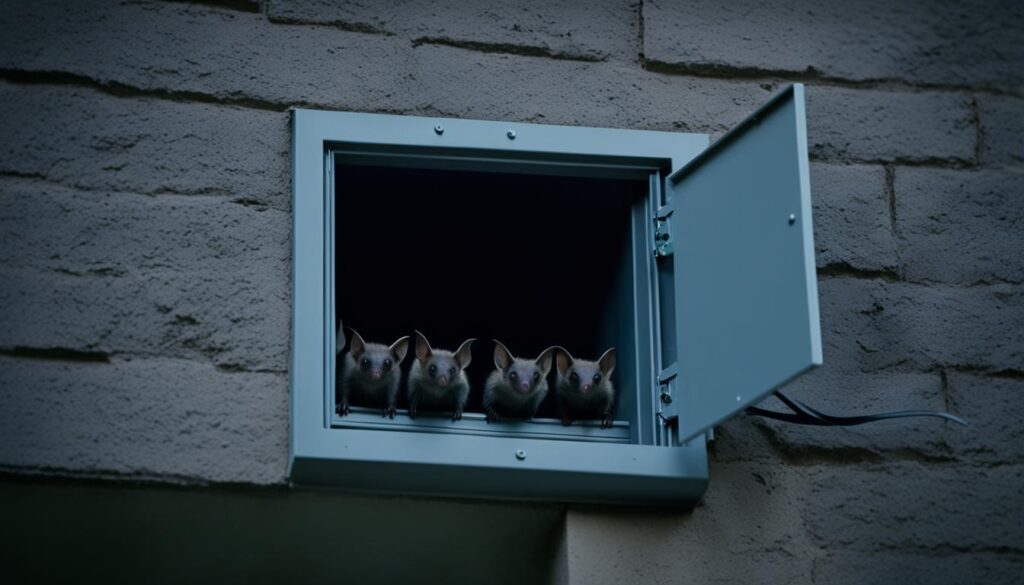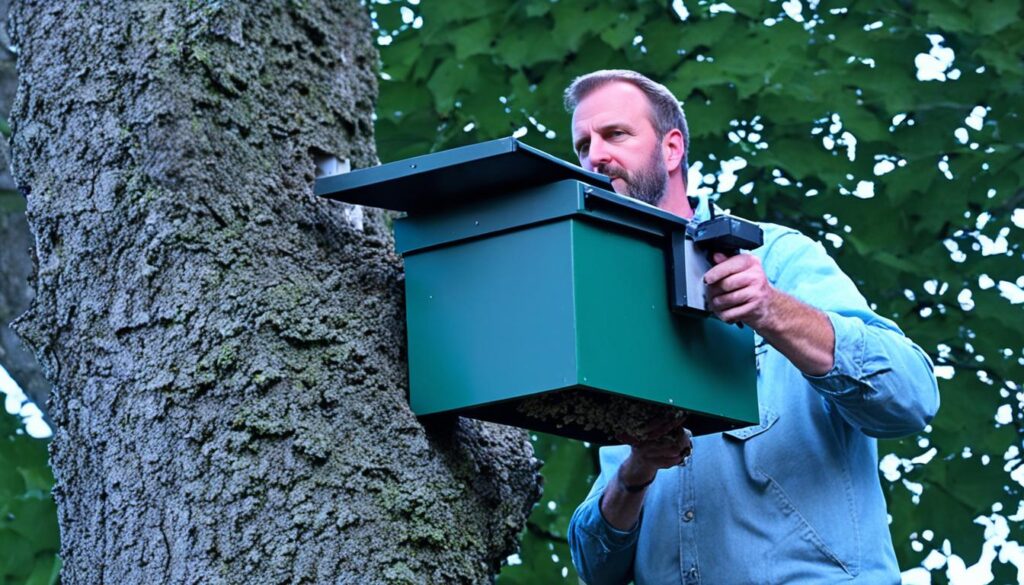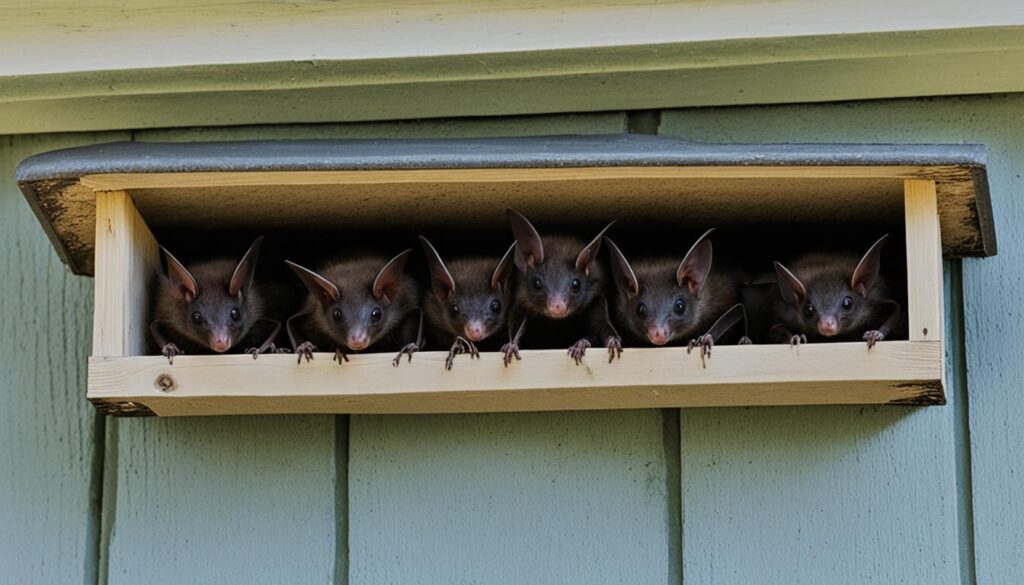Have you ever experienced the unsettling feeling of bats flying around in your home? I certainly have. A few months ago, I was startled awake in the middle of the night by the flapping of wings and the faint squeaking sounds that pierced through the darkness. As I turned on the light, I realized that my peaceful abode had been invaded by a bat infestation.
At that moment, fear and uncertainty overwhelmed me. I knew I had to find a way to remove the bats from my home safely and humanely. In my quest to regain a sense of security, I discovered valuable tips and techniques that not only helped me resolve the issue but also served as a reminder of the importance of bat conservation.
If you are currently facing a bat infestation in your home, rest assured that you are not alone. In this article, I will share with you the safest and most humane tips for removing bats from your home. Whether you wish to tackle the problem yourself or seek professional assistance, these insights will empower you to effectively deal with the bat infestation and create a bat-free environment in your home.
Key Takeaways:
- Understanding bat behavior and the risks associated with a bat infestation is essential before attempting removal.
- Assess the extent of the bat infestation and look for signs of their presence to tailor your removal approach.
- Explore natural deterrents and repellents, as well as DIY techniques for bat removal.
- Learn about effective exclusion techniques for safely removing bats from your home.
- Consider hiring professional bat control services for a swift and efficient resolution.
Understanding Bat Behavior and Risks
Before attempting to remove bats from your home, it’s crucial to gain a deeper understanding of their behavior and the potential risks associated with a bat infestation. By knowing what makes these creatures tick and the dangers they pose, you can effectively address the situation and ensure the safety of your family and property.
Insights into Bat Behavior Patterns
Bats are nocturnal creatures, meaning they are most active at night. They possess exceptional nocturnal navigation skills, primarily relying on echolocation to navigate and locate their prey. This remarkable ability allows them to emit ultrasonic sounds and interpret the echoes bouncing back from objects or insects in their vicinity.
Bats typically prefer dark, secluded areas for roosting, such as attics, caves, or tree hollows. They are social creatures, often forming colonies consisting of dozens or even hundreds of individuals from the same species. Plus, certain bat species migrate seasonally to find suitable food and roosting habitats.
“Bats are fascinating creatures with unique adaptations for nighttime living.”
While bats serve a beneficial purpose in maintaining ecological balance by controlling insect populations, their presence in homes can lead to various issues that require prompt intervention.
Potential Health Hazards of Bat Infestations
Although bats are generally shy and prefer to avoid interactions with humans, a bat infestation can pose significant health risks. These risks primarily stem from the potential transmission of diseases that bats may carry, such as rabies.
Rabies is a viral disease that affects the central nervous system and is transmitted through the saliva of an infected bat. While the prevalence of rabies in bats is relatively low, it’s crucial to exercise caution and avoid direct contact with bats, their droppings, or any exposed materials contaminated with bat urine or feces.
Bat droppings, also known as guano, can accumulate over time and pose respiratory health hazards. The feces contain fungal spores, such as Histoplasma capsulatum, which can cause a lung infection called histoplasmosis. This disease typically affects individuals with weakened immune systems and can lead to flu-like symptoms or more severe respiratory issues.
Additionally, the physical presence of bats in your home can cause structural damage due to their nesting habits. They may gnaw on electrical wires, insulation, or other materials to create suitable roosting spots, potentially increasing the risk of fire hazards or compromising the structural integrity of your property.
It is crucial to approach the removal of bats from your home with both caution and respect, ensuring the safety of yourself, your family, and the bats themselves. By understanding their behavior patterns and the potential health risks they pose, you can take the necessary steps to address the infestation effectively.
Assessing the Bat Infestation
Identifying the extent of the bat infestation and understanding the signs of their presence are crucial for effective removal. By assessing the bat infestation in your home, you can tailor your removal approach accordingly, ensuring a successful and thorough bat removal process. Here are some key steps to help you assess the bat infestation:
- Inspecting the Exterior: Begin by examining the exterior of your home for any signs of bat activity. Look for bat droppings, also known as guano, near entry points such as eaves, vents, and gaps in the roofline.
- Examining the Interior: Once you’ve identified potential entry points from the outside, carefully inspect the interior of your home. Keep an eye out for guano accumulation, which typically appears as dark-colored pellets on the floor, windowsills, or attic spaces. Additionally, listen for any unusual noises during the evening or early morning hours, as bats are nocturnal creatures.
- Tracking Bat Flight Patterns: Observing the flight patterns of bats around your property can provide valuable insights. Stand outside during dusk or dawn, and pay attention to where the bats enter and exit your home. This information will help you locate the primary access points that need to be addressed during the removal process.
- Seeking Professional Assistance: If you’re unsure about assessing the bat infestation on your own, consider reaching out to a professional bat removal service. They have the expertise and experience to accurately assess the infestation and provide effective solutions tailored to your specific situation.
Remember, assessing the bat infestation is the crucial first step towards successful removal. Understanding the extent of the infestation will guide your efforts in creating a bat-free environment in your home.
Expert Tip:
When inspecting your home for signs of bat presence, be cautious and avoid direct contact with bats or their droppings. Bats can carry diseases such as rabies, and their droppings may contain harmful fungi. It’s always best to prioritize your safety and seek professional guidance if needed.
By following these steps, you’ll be better equipped to assess the bat infestation and make informed decisions about the best removal approach for your home. In the next section, we will explore natural bat deterrents and repellents that can help you create a bat-free environment.
Natural Bat Deterrents and Repellents
When it comes to removing bats from your home, natural deterrents and repellents can be effective solutions. Not only are they safe and humane, but they can also help create a bat-free environment in your home. In this section, we will explore DIY techniques and natural remedies that you can try.
1. Lighting
Bats are nocturnal creatures, so they prefer dark environments. By installing bright lights around your home, especially near their entry points, you can discourage bats from entering. Motion-activated lights can be particularly effective in deterring these flying mammals.
2. Ultrasonic Devices
Ultrasonic devices emit high-frequency sounds that are unpleasant to bats. While these sounds are harmless to humans and pets, they can irritate bats and discourage them from roosting in your home. Place these devices near the areas where bats are most active for better results.
3. Essential Oils
Several essential oils can act as natural repellents for bats. Peppermint, eucalyptus, and cinnamon oils are known to have strong scents that bats find off-putting. Mix a few drops of these oils with water and spray the solution around bat entry points or areas where bats have been spotted.
4. Noise and Disturbance
Bats prefer quiet and undisturbed areas for roosting. Creating noise and disturbance can make them uncomfortable and encourage them to find alternative locations. You can use different methods, such as playing loud music or using wind chimes, to disrupt their peaceful environment.
5. Seal Entry Points
Preventing bats from entering your home in the first place is crucial. Inspect your home for any gaps, cracks, or openings that bats can use as entry points. Seal off these areas with caulk, mesh screens, or other appropriate materials to block their access.
Remember, while these natural deterrents and repellents can be effective, they may not work in all situations. It’s important to use them alongside other bat removal techniques for best results.
Important: If you decide to use deterrents or repellents, always prioritize the safety and well-being of both yourself and the bats. Ensure that the methods you choose won’t harm the bats or violate any local wildlife protection laws.
| Pros | Cons |
|---|---|
| Safe and humane | Effectiveness may vary |
| Environmentally friendly | May require ongoing maintenance |
| Cost-effective | Not a standalone solution |
| Easy to implement |
Exclusion Techniques for Bat Removal
When it comes to safely removing bats from your home, exclusion techniques are key. These methods not only ensure the bats are removed without harm but also prevent them from returning. In this section, we will explore the best practices and effective tips to ensure a successful bat removal process. By following these guidelines, you can safely and humanely address a bat infestation in your home.
1. Inspect Your Property for Entry Points
Start by thoroughly inspecting your property for any potential entry points bats might use to access your home. Focus on areas such as gaps in rooflines, chimneys, vents, and cracks in walls. Seal off these entry points using materials like weatherstripping, wire mesh, or caulk. By eliminating their access points, you can prevent bats from re-entering your home.
2. Install Bat Houses
Providing an alternative roosting spot for bats can help divert them away from your home. Install bat houses in suitable locations around your property, such as along tree lines or on the side of your house. These specially designed structures provide shelter for bats and can encourage them to roost in a safe and designated area away from your living space.
3. Use Exclusion Devices
Exclusion devices are tools specifically designed to allow bats to exit your home but not re-enter. One popular device is the bat cone or funnel, which is placed over the entry point. This allows bats to fly out but prevents them from returning. It’s essential to leave the exclusion devices in place for a few days to ensure all the bats have left your home.
Tip: Exclusion devices should only be installed during specific times of the year when bats are not rearing their young, as separating mothers from their pups is cruel.
4. Seek Professional Assistance
If you’re unsure about safely implementing exclusion techniques or if the bat infestation is particularly severe, it’s recommended to seek professional bat removal services. These professionals have the experience and expertise to safely remove bats from your home and implement effective exclusion techniques. They can also address any potential health hazards associated with the infestation.
5. Ensure Proper Clean Up
After successfully removing bats from your home, it’s crucial to clean up any droppings or guano that may be present. Bat droppings can pose health risks, so make sure to wear protective gear such as gloves and masks when handling them. Disinfect the area and properly dispose of the waste following local regulations.
By utilizing these proven exclusion techniques, you can safely remove bats from your home and prevent future infestations. However, it’s important to remember that bats are protected species in many areas, and it’s crucial to respect their conservation. If in doubt, always consult local wildlife authorities or experts for guidance.

| Exclusion Techniques for Bat Removal | Advantages |
|---|---|
| Inspect Your Property for Entry Points | – Prevents bats from accessing your home – Addresses potential areas of vulnerability |
| Install Bat Houses | – Provides alternative roosting spots – Diverts bats away from your living space |
| Use Exclusion Devices | – Allows bats to exit but not re-enter – Effective way to remove bats from your home |
| Seek Professional Assistance | – Expertise in safe bat removal process – Deals with severe bat infestations |
| Ensure Proper Clean Up | – Removes health hazards – Maintains a hygienic environment |
Hiring Professional Bat Control Services
If you prefer to leave bat removal to the experts, professional bat control services can provide you with the expertise and resources needed to handle your bat infestation effectively. Hiring professionals ensures a swift and efficient resolution to your bat problem, giving you peace of mind knowing that the issue is being handled by experienced professionals.
When it comes to bat control, professionals have the necessary knowledge and tools to safely and legally remove bats from your home. They understand the behavior and habits of bats, allowing them to develop targeted strategies for removal and prevention. Their expertise minimizes the risk of harm to both you and the bats themselves.
Hiring professionals also ensures that appropriate measures are taken to prevent future bat infestations. They can identify and seal entry points, making it difficult for bats to re-enter your home. By addressing these vulnerabilities, you can create an environment that is inhospitable to bats, reducing the chances of another infestation.
âProfessional bat control services offer the necessary expertise and resources to effectively remove bats from your home and prevent future infestations.â
Moreover, professional bat control services provide an added layer of convenience. They take care of the entire process, from initial assessment to final removal, allowing you to focus on other important aspects of your life.
Hiring professionals for bat control services is particularly beneficial when dealing with larger or more complex infestations. They have the capacity to handle multiple bats or colony removals, ensuring the safety and well-being of both you and the bats.
Benefits of Hiring Professional Bat Control Services:
- Expertise and knowledge of bat behavior
- Safe and legal bat removal
- Prevention of future bat infestations
- Identification and sealing of entry points
- Convenience and peace of mind
- Capacity to handle larger or complex infestations
By opting for professional bat control services, you can ensure that your bat infestation is resolved efficiently and effectively. Their expertise and resources will help you create a bat-free environment and protect your home from future bat-related issues.
Bat-Proofing Your Home
Now that you have successfully removed the bats from your home, it’s time to take proactive measures to bat-proof your property and prevent future infestations. By sealing bat entry points, you can safeguard your home against their re-entry. Here are some essential tips to help you effectively bat-proof your home:
1. Identify and Seal Entry Points
To keep bats out, it’s crucial to identify and seal all potential entry points. Carefully inspect your home for gaps, cracks, and openings in the exterior, such as around windows, doors, vents, and chimneys. Use high-quality sealants or caulking materials to close off these entry points and ensure a tight seal.
2. Install Bat-Proof Screens
Consider installing bat-proof screens on windows, doors, and other openings that need ventilation. These screens have a finer mesh that prevents bats from entering while still allowing fresh air to flow into your home.
3. Utilize Exclusion Devices
Incorporate exclusion devices, such as one-way bat doors or bat cones, on known bat entry points. These devices allow bats to exit your home but prevent them from re-entering. Ensure you install exclusion devices correctly to avoid trapping bats inside your home.
4. Secure Attic Access Points
Since bats commonly roost in attics, it’s essential to secure any access points leading to your attic. Install mesh or netting over vents, chimneys, and other openings to prevent bats from entering this space. Regularly inspect and maintain the integrity of these barriers.
5. Trim Tree Branches
If you have trees close to your home, ensure that tree branches are trimmed and kept away from your roof. Bats can use overhanging branches as a bridge to access your home. By keeping branches a safe distance away, you reduce the likelihood of bats gaining entry.
| Benefits of Bat-Proofing Your Home |
|---|
| 1. Prevents future bat infestations |
| 2. Safeguards your health and property |
| 3. Reduces potential damage caused by bats |
| 4. Promotes a bat-free environment |
By following these bat-proofing tips, you can ensure your home remains free from future infestations and create a safe living space for you and your family.
Dealing with Bat Droppings and Guano
After successfully removing bats from your home, it’s crucial to address the issue of bat droppings and guano. These waste materials can pose health risks and require proper clean-up to ensure a hygienic environment for you and your family.
Bat droppings, also known as guano, may contain harmful bacteria and fungi that can cause respiratory problems when inhaled. It’s important to handle bat droppings with caution to avoid any potential health hazards.
If you’re dealing with bat droppings and guano, follow these steps to safely clean up the affected areas:
- Put on protective gear: Wear disposable gloves, a face mask, and safety goggles to minimize direct contact with the droppings and prevent inhalation of any particles.
- Isolate the area: Close off the affected area to prevent the spread of droppings and contaminants to other parts of your home.
- Clean the droppings: Use a damp cloth or paper towel to carefully pick up the droppings, ensuring that you don’t disperse dust or particles into the air. Avoid vacuuming or sweeping, as this may release harmful spores.
- Disinfect the area: After removing the droppings, thoroughly clean the affected surfaces with a disinfectant solution. This will help kill any remaining bacteria or fungi.
- Dispose of waste properly: Place the collected droppings and cleaning materials in a sealed plastic bag. Dispose of it in an outdoor trash bin to prevent contamination.
- Wash your hands: After completing the clean-up process, wash your hands thoroughly with soap and water. Dispose of the gloves, mask, and goggles properly.
It’s important to note that if you’re unsure about how to handle bat droppings or if the infestation is extensive, it’s best to seek professional assistance. They have the expertise and specialized equipment to safely handle guano clean-up.
Remember, proper clean-up of bat droppings and guano is essential for maintaining a healthy living environment. By taking the necessary precautions and following these guidelines, you can eliminate potential health risks associated with bat waste.
Seeking Legal Considerations
When it comes to removing bats from your home, it’s essential to be aware of the legal considerations that may apply in your area. Different regions may have specific regulations, obligations, or restrictions regarding bat removal. To ensure you stay within the bounds of the law and avoid any potential legal issues, it’s crucial to understand and comply with the relevant laws and regulations.
If you attempt to remove bats from your property without adhering to the legal requirements, you could face penalties or consequences. Additionally, some bat species are protected by law due to their ecological importance, which further emphasizes the need to approach bat removal responsibly and lawfully.
In this section, we will provide insights and tips to help you navigate the legal considerations associated with bat removal. By understanding and following the legal requirements, you can ensure a successful and compliant bat removal process.
Understanding Local Regulations and Wildlife Laws
Start by researching and familiarizing yourself with the local regulations and wildlife laws governing bat removal in your area. Consult your state or local wildlife agency, department of natural resources, or local authorities to gather information on any specific permits, licenses, or guidelines that may be required. They are the best source of accurate and up-to-date information, ensuring you have the necessary knowledge to comply with the law.
Engaging Professional Assistance
In some cases, seeking professional bat control services may be the safest and most legally compliant option. Professional bat removers are well-versed in the legal considerations associated with bat removal and can ensure that all necessary permits and guidelines are followed. When hiring a professional service, make sure to inquire about their experience, qualifications, and adherence to local wildlife laws.
Did You Know?
Removing or disturbing bat colonies without the proper permits can result in legal consequences and fines. Protect yourself and the bats by understanding the legal considerations surrounding bat removal.
Consulting Legal Experts
If you’re uncertain about the legal requirements or have complex legal concerns related to bat removal, it’s advisable to consult with legal experts specializing in wildlife or environmental law. They can provide you with tailored advice based on your specific situation and guide you through the legal complexities associated with bat removal.
Legal Considerations Table
| Legal Consideration | Description |
|---|---|
| Permits and Licenses | Understanding the permits or licenses required for bat removal and ensuring compliance with application processes and regulations. |
| Protected Species | Familiarizing yourself with bat species protected by law and the specific restrictions or protocols that apply to their removal. |
| Timing and Seasonal Restrictions | Being aware of timeframes or seasonal restrictions during which bat removal may be limited or prohibited to protect breeding or hibernation periods. |
| Safe Handling and Relocation | Understanding the guidelines for safely handling and relocating bats, if permitted, while ensuring their welfare and preventing harm. |
| Public Health and Safety | Taking into account public health and safety considerations associated with bat removal, particularly when dealing with communal living spaces or public buildings. |
Understanding the legal considerations for bat removal is crucial for ensuring a responsible and compliant approach. By following the appropriate legal requirements and seeking professional guidance when needed, you can effectively remove bats from your home while safeguarding both yourself and the bats involved.
Continue reading to learn about bat-proofing your home and preventing future bat infestations.

Educating Others About Bat Conservation
Bats are not only fascinating creatures but also play a crucial role in maintaining a balanced ecosystem. By promoting bat conservation and creating bat-friendly environments, you can contribute to their well-being and the health of our planet. Here are some effective ways to educate others about the importance of bats:
- Organize educational workshops: Conduct workshops or seminars to raise awareness about bat conservation. Invite experts to share their knowledge and experiences, highlighting the vital role bats play in pollination and insect control.
- Create informational resources: Develop brochures, pamphlets, or online resources that provide comprehensive information about bats and their significance in the ecosystem. Distribute these resources in schools, libraries, and community centers.
- Collaborate with local organizations: Work with local conservation organizations, wildlife centers, or educational institutions to implement bat conservation initiatives. This collaboration can help reach a wider audience and maximize the impact of your efforts.
- Engage in social media campaigns: Utilize social media platforms to share interesting facts, stories, and photographs of bats. Encourage people to share these posts to create a buzz and increase awareness among their networks.
- Host bat-watching events: Organize bat-watching events in collaboration with nature clubs or bird watching groups. These events can provide an opportunity for people to observe bats in their natural habitat and learn more about their behavior and conservation needs.
- Support local bat conservation projects: Identify local bat conservation projects or organizations in your area and volunteer your time or contribute financially to support their initiatives. Your support can help fund research, habitat restoration, and awareness campaigns.
“Bats are not only fascinating creatures but also play a crucial role in maintaining a balanced ecosystem.”
“In the end, we will conserve only what we love, we will love only what we understand, and we will understand only what we are taught.”
– Baba Dioum
Remember, by educating others about bat conservation, you are empowering them to take action and make a positive impact on bat populations. Together, let’s create a world where bats thrive and continue to benefit our environment.
| Benefits of Bat Conservation | |
|---|---|
| Bat Population Control | By consuming vast numbers of insects, bats help control pest populations, reducing the need for harmful pesticides in agriculture. |
| Pollination | Many bat species are important pollinators for various plants, including economically valuable ones like cocoa, bananas, and agave (used to make tequila). |
| Seed Dispersal | Bats disperse seeds as they consume fruits, aiding in forest regeneration and maintaining biodiversity. |
| Economic Impact | Bat conservation contributes to the stability of ecosystems, supporting tourism, agriculture, and various industries dependent on healthy environments. |
| Biological Research | Bats serve as valuable subjects for scientific research, providing insights into flight, echolocation, and immune system adaptations. |
Conclusion
In conclusion, by following the safe and humane tips discussed in this article, you can effectively remove bats from your home. First and foremost, it is important to assess the extent of the bat infestation in your home. Look for signs of their presence, such as bat droppings or scratching noises in the attic or walls. Understanding the behavior and risks associated with bats will also help you approach their removal with caution.
When it comes to removing bats from your home, you have multiple options. Consider using natural deterrents and repellents, such as installing bat houses or using aromatic plants, to create a bat-free environment. Alternatively, you can enlist the services of professional bat control experts, who have the knowledge and experience to safely handle bat removal.
To prevent future bat infestations, it is essential to bat-proof your home. Seal all potential entry points, such as cracks in the walls or gaps in the roof, as bats can squeeze through even small openings. By taking the necessary steps to bat-proof your home, you can ensure a long-term solution and maintain a bat-free environment.
Finally, while removing bats from your home, it is crucial to keep in mind the importance of bat conservation. Bats play a critical role in ecosystem balance, pollination, and insect control. By promoting bat-friendly environments and educating others about the benefits of bats, we can contribute to their conservation efforts and create a harmonious coexistence between humans and bats.
FAQ
How can I safely remove bats from my home?
Safely removing bats from your home is essential to protect both yourself and the bats. It is best to hire professional bat control services that specialize in humane bat removal methods. They will assess the infestation, safely exclude the bats, and provide guidance on bat-proofing your home.
Are there any natural bat deterrents or repellents?
Yes, there are natural deterrents that can help keep bats away from your home. Some popular options include installing bat houses nearby to provide an alternative roosting spot, using bright lights or motion-activated devices, and planting strong-smelling herbs like peppermint or garlic around the entry points.
What are the best exclusion techniques for bat removal?
Effective exclusion techniques for bat removal include sealing all potential entry points, such as gaps in the roof, vents, and chimneys. Using exclusion devices like one-way doors can also help. It is crucial to ensure that all exclusion methods are implemented safely and without harming the bats.
Should I hire professional bat control services?
Hiring professional bat control services is highly recommended, especially if you are unsure about how to safely remove bats or have a large infestation. Professionals have the expertise, specialized equipment, and permits necessary for humane bat removal while ensuring the safety of both the bats and your home.
How do I bat-proof my home after removing bats?
Bat-proofing your home is crucial to prevent future infestations. Seal all potential entry points using materials like caulk, mesh screens, or weatherstripping. Ensure all vents have secure covers and trim trees near your home to reduce roosting opportunities. Regularly inspect and maintain these bat-proofing measures.



